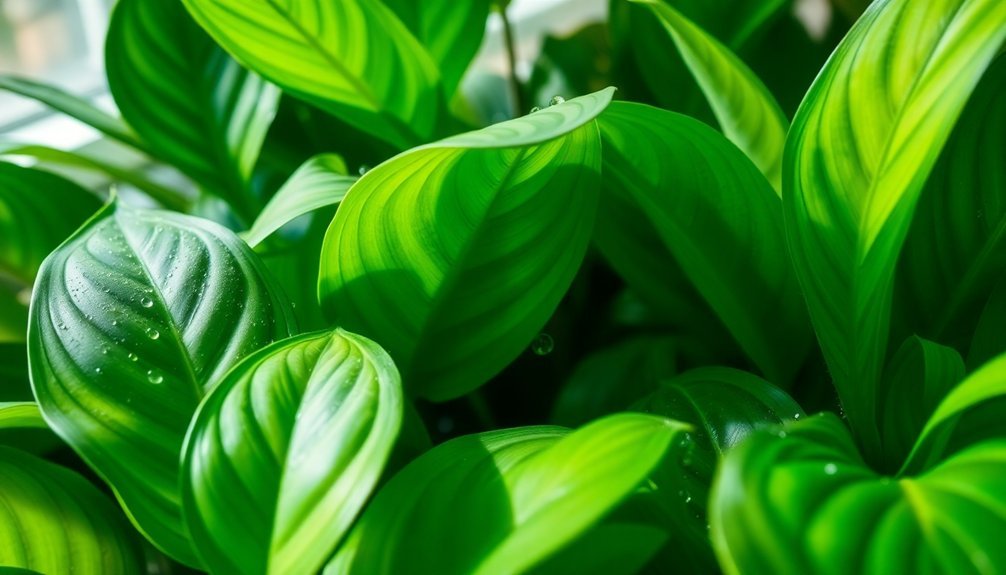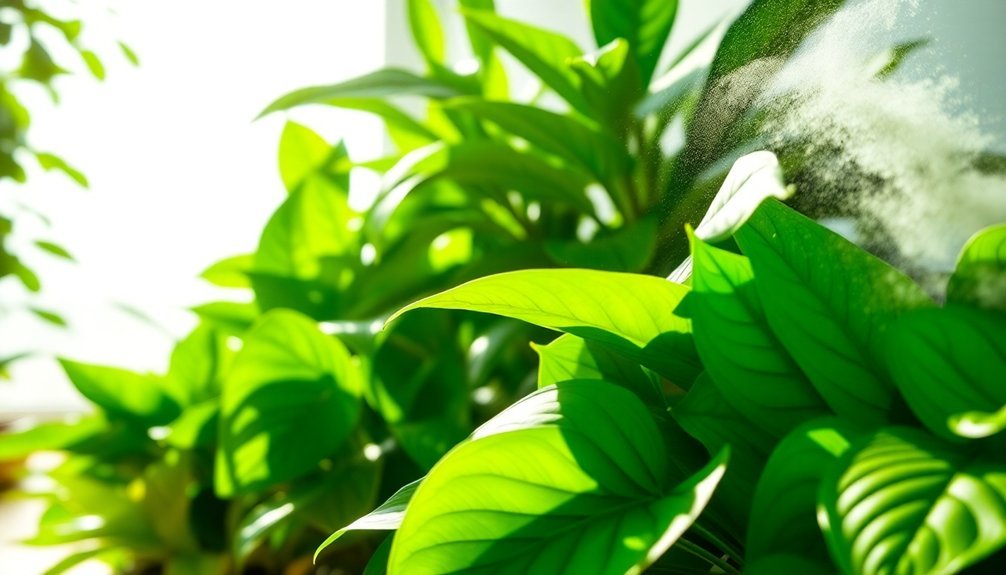Want to purify your indoor air naturally? The top 7 leafy air-purifiers include Spider Plants (removing 95% of VOCs in 24 hours), Peace Lilies (filtering benzene and formaldehyde), Bamboo Palms (neutralizing ammonia), Rubber Trees (reducing mold by 60%), Snake Plants (producing oxygen at night), Chinese Evergreens, and Golden Pothos. You'll need at least two plants per 100 square feet for maximum effectiveness. Discover how to position and maintain these natural air cleaners for ideal results.
Most Effective Plants for Eliminating Indoor VOCs

Five powerhouse plants stand out as nature's most effective air purifiers for tackling indoor volatile organic compounds (VOCs).
You'll find the Spider Plant leading the pack, removing 95% of harmful VOCs within just 24 hours.
The Peace Lily works wonders in low light conditions, filtering common household toxins like benzene and formaldehyde from your indoor air.
For tropical appeal combined with air-purifying prowess, consider the Bamboo Palm, which excels at neutralizing ammonia and formaldehyde.
The versatile Rubber Tree adapts to various lighting conditions while efficiently eliminating airborne toxins.
Don't overlook the Chinese Evergreen – this hardy air purifying houseplant not only boosts your mood but also effectively filters multiple chemicals, including trichloroethylene, to clean the air in your living space.
Top-Performing Leafy Plants for Chemical Gas Removal
When you're looking to combat indoor air pollution, several powerhouse plants stand out for their remarkable ability to eliminate chemical gases.
The Spider Plant leads the pack by removing 95% of airborne chemicals within just 24 hours, while the Rubber Tree excels at filtering formaldehyde and reducing mold by up to 60%.
You'll find exceptional performers in the Peace Lily and Snake Plant, which tackle multiple toxins including benzene and trichloroethylene, making them versatile additions to any indoor space.
Potent Gas-Fighting Champions
Natural warriors in the battle against indoor air pollution, these top-performing leafy plants excel at removing harmful chemical gases from your living spaces.
You'll find the Spider Plant particularly impressive, as it eliminates 95% of airborne chemicals within just 24 hours. The Snake Plant stands out by producing oxygen at night while filtering toxins like benzene.
For clean air around the clock, combine these Air-Purifying Plants with the formaldehyde-fighting Rubber Tree and the versatile Chinese Evergreen.
The latter not only removes benzene but also boosts your productivity. Don't forget the Peace Lily – its elegant white blooms complement its powerful ability to filter multiple harmful chemicals from your indoor environment.
These plants work tirelessly to transform your space into a healthier sanctuary.
Versatile Indoor Toxin Removers
These versatile leafy champions offer exceptional air-purifying power for any room in your home.
Among the best indoor plants for purifying the air, Spider Plants stand out by eliminating 95% of toxic gases within just 24 hours.
You'll find the Rubber Tree particularly effective at battling formaldehyde and mold spores, reducing these pollutants by up to 60%.
For low-light areas, Peace Lilies excel at removing benzene and trichloroethylene while adding elegant white blooms to your space.
The Chinese Evergreen proves its worth by filtering multiple toxins, including carbon monoxide, while boosting your productivity.
In humid spaces like bathrooms, the Bamboo Palm serves double duty – it's not just effective at filtering ammonia and formaldehyde but also acts as a natural humidifier.
Scientific Research Behind Plant Air Purification

NASA's groundbreaking Clean Air Study reveals that certain indoor plants can remove up to 87% of airborne toxins within just 24 hours through a process called phytoremediation.
You'll find that plants actively absorb harmful VOCs through their leaves and root systems, breaking down these compounds into harmless substances through their natural metabolic processes.
The science shows that you need at least two air-purifying plants per 100 square feet to achieve ideal air-cleaning benefits, making it essential to strategically place your leafy air purifiers throughout your space.
NASA Clean Air Studies
While many people know that houseplants can purify air, groundbreaking research from the NASA Clean Air Study has provided scientific proof of their effectiveness. The research shows that certain plants can eliminate up to 87% of volatile organic compounds within just 24 hours, making them powerful natural air purifiers for your home.
You'll find the Spider Plant, Peace Lily, and Bamboo Palm particularly effective at filtering toxins while boosting oxygen levels.
To maximize your indoor air quality benefits, you'll want to place at least two substantial plants per 100 square feet. This scientific validation has transformed how we view plants' role in creating healthier indoor environments, offering a sustainable solution that's both beautiful and effective.
The Environmental Protection Agency now recognizes these natural carbon filters as valuable tools for maintaining cleaner indoor air.
Phytoremediation Process Explained
Understanding how plants purify air through phytoremediation reveals nature's sophisticated filtration system at work. Your indoor plants aren't just decorative; they're actively cleaning your air through a remarkable process that targets harmful volatile organic compounds and other toxins.
When you bring plants into your home, they work through two main pathways to absorb pollutants. Their leaves capture airborne chemicals, while their roots process contaminants from soil and water.
Through phytoremediation, plants convert these dangerous substances into harmless compounds or store them safely in their tissues. This natural process can reduce indoor air toxins by up to 60%, making your space considerably healthier.
Different plants excel at removing specific pollutants – for instance, Peace Lilies tackle ammonia, while Rubber Trees target formaldehyde, demonstrating nature's specialized approach to improving indoor air quality.
Placement Strategies for Maximum Air Cleaning
Getting the most out of your leafy air-purifiers depends heavily on strategic placement throughout your home. You'll want to position at least two plants per 100 square feet to maximize air purification. Place Bamboo Palms and Spider Plants near windows for ideal sunlight exposure, while utilizing corners and shelves for Snake Plants and Golden Pothos that thrive in indirect light.
| Plant Type | Best Location | Benefits |
|---|---|---|
| Bamboo Palm | Near Windows | Enhanced Growth |
| Spider Plant | Windowsills | Maximum Filtering |
| Snake Plant | Corners | Toxin Removal |
| Golden Pothos | Shelves | Space Efficiency |
| Multiple Plants | Grouped Areas | Higher Humidity |
Create small plant clusters to boost humidity and enhance toxin removal. Remember to avoid high-traffic areas and direct vent airflow, as these can diminish your plants' air-purifying effectiveness.
Maintenance Requirements for Air-Purifying Plants

To keep your leafy air-purifiers thriving, you'll need to follow specific maintenance routines tailored to each plant type.
Start by establishing a balanced watering schedule – plants like Spider Plants and Peace Lilies shouldn't be overwatered, as this can lead to root rot.
Over-pampering your air-purifying plants with too much water can be their downfall. Balance is key to preventing root damage.
Dust the leaves regularly to maximize their air-purifying capabilities and photosynthesis efficiency.
For humidity-loving plants like Boston Ferns and Aloe Vera, you'll want to mist them frequently or place them in naturally humid spaces.
Pay attention to your plants' growing needs – versatile options like Rubber Trees and Snake Plants adapt well to different lighting conditions, making maintenance easier.
Don't forget to repot larger species such as Bamboo Palms every few years to guarantee they've enough space for healthy root development and continued air-cleaning effectiveness.
Combining Plants for Enhanced Air Quality
While proper plant maintenance sets the foundation, creating a powerhouse air-purifying system requires strategic plant combinations.
You'll get the best air purifying results by placing at least two substantial plants per 100 square feet, particularly effective when you mix species that target different pollutants.
Spider Plants and Peace Lilies are a particularly effective duo – Spider Plants tackle formaldehyde while Peace Lilies clean benzene and trichloroethylene from your air.
To enhance overall air quality further, combine Snake Plants with Bamboo Palms to boost humidity levels while removing various toxins.
Don't forget about darker spaces – pair Chinese Evergreens with Philodendron Heartleaf plants to maintain purifying power even in low-light areas.
These strategic combinations guarantee you're targeting the widest range of indoor pollutants possible.
Measuring Your Plants' Impact on Indoor Air

Measuring your indoor plants' air-purifying impact doesn't require complex equipment or scientific expertise. You can monitor your space's air quality improvement by observing several key indicators.
Start by noting the number of plants you have per 100 square feet – you'll need at least two substantial air-purifying plants for ideal results.
For optimal air purification, aim to place a minimum of two large plants within every 100 square feet of indoor space.
Watch how your plants remove toxins by tracking changes in common symptoms of poor air quality, such as reduced headaches or better sleep. Monitor your plants' effectiveness by placing them in areas where you spend the most time, like your bedroom or home office.
Spider Plants and Peace Lilies are particularly efficient – they'll show results within 24 hours. To maximize their impact, make certain your indoor plants have proper light and care, as healthier plants are more effective at converting carbon dioxide and filtering harmful compounds.
Frequently Asked Questions
Do Air Purifiers Get Rid of Toxic Fumes?
Yes, air purifiers effectively eliminate toxic fumes. With HEPA and activated carbon filters, they'll remove up to 99.97% of harmful particles and gases like VOCs, benzene, and formaldehyde from your indoor air.
What Is the Best Air Purifier to Remove VOCS?
You'll get the best VOC removal with air purifiers featuring activated carbon filters, like the BreatheSmart 45i or FLEX. They're highly rated and effectively absorb harmful gases while covering various room sizes.
Do Air Purifiers Remove Toxins From the Air?
Yes, air purifiers do remove toxins from your indoor air. You'll get the best results with units that combine HEPA filters and activated carbon, which effectively capture both particle pollutants and harmful gases.
Which Air Purifier Destroys Formaldehyde?
You'll find BreatheSmart air purifiers with HEPA and activated carbon filters effectively destroy formaldehyde. They're specially designed to tackle this gas, but remember to replace filters regularly for peak performance.
In Summary
You'll breathe easier knowing these seven leafy air-purifiers are working around the clock to remove harmful VOCs from your home. Place them strategically, maintain them properly, and combine different species for maximum impact. Monitor your indoor air quality to see the difference they make. With these natural purifiers, you're taking a simple but effective step toward a healthier living environment.





Leave a Reply